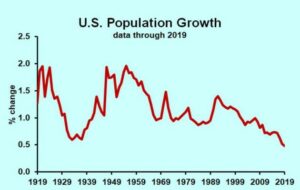U.S. birthrate drops to lowest level in more than 40 years
The U.S. birthrate in 2020 fell to its lowest level in more than four decades, according to the U.S. Centers for Disease Control and Prevention.
Experts say the country and much of the western world will experience a demographic time bomb, where babies aren’t being born at a high enough rate to replace the existing population. It’s a trend that public health experts have worried about for years because it could impact countries’ economies, resource distribution, and workforce potential.
The agency estimated some 3.6 million babies were born in the United States in 2020, down 4 percent from 2019. And you can’t just blame pandemic. It was the sixth consecutive year that the number of births has declined, down an average of 2 percent per year. The provisional birthrate report published Wednesday by the CDC is based on a review of 99.87 percent of birth certificates issued in 2020.
 The general fertility rate was down by 4 percent from 2019, another record low for the United States, at 55.8 births per 1,000 women aged 15–44 in 2020. The rate dropped for mothers of every major race and ethnicity, and in nearly every age group, except for adolescents aged 10–14 and women aged 45–49. Meanwhile, the total fertility rate also was down by 4 percent from 2019, at yet another record low, at 1,637.5 births per 1,000 women in 2020.
The general fertility rate was down by 4 percent from 2019, another record low for the United States, at 55.8 births per 1,000 women aged 15–44 in 2020. The rate dropped for mothers of every major race and ethnicity, and in nearly every age group, except for adolescents aged 10–14 and women aged 45–49. Meanwhile, the total fertility rate also was down by 4 percent from 2019, at yet another record low, at 1,637.5 births per 1,000 women in 2020.
Births have been declining in younger women for years, as many postponed motherhood and had smaller families. Birthrates for women in their late 30s and in their 40s have been inching up, but not in 2020. “The fact that you saw declines in births even for older moms is quite striking,” said Brady Hamilton of the CDC, the lead author of the new report.
The CDC did not attribute the overall decline to the COVID-19 pandemic, but reasons including anxiety will affect the country’s birthrate.
“The recent decline in birthrates reflects both a longer-term downward trend in birthrates that was apparent prior to the pandemic and pandemic-related reduction,” said Lorna Thorpe, director of epidemiology at the Department of Population Health at NYU Langone.
Dr. Shanna Swan, an epidemiologist based at Icahn School of Medicine at Mount Sinai in New York City, suggests in a new book published earlier this year that endocrine disruptors may be contributing to a decline in sperm counts over the recent decades, and thereby playing a role in the declining fertility rate across the globe.
CBS News reported that, by some measures, the U.S. is already below the “replacement level”, meaning fewer young people to support the country’s otherwise aging population.
“That’s a crisis,” says University of Southern California Professor Dowell Myers, who studies demographic trends.
“We need to have enough working-age people to carry the load of these seniors, who deserve their retirement, they deserve all their entitlements, and they’re gonna live out another 30 years,” he said. “Nobody in the history of the globe has had so many older people to deal with.”
In a survey of more than 1,000 women from personal finance company SoFi, one-third of women of child-bearing age said the pandemic influenced their decision to have children. About 61% said they were more anxious about their ability to support children at this time, with 41% specifically citing financial reasons.
Almost 1 in 5 of all pregnancies in the U.S. end in elective abortions.
–Dwight Widaman | Metro Voice






